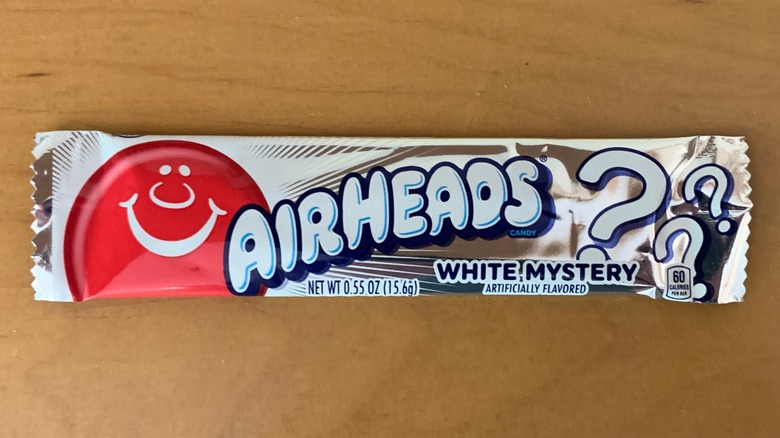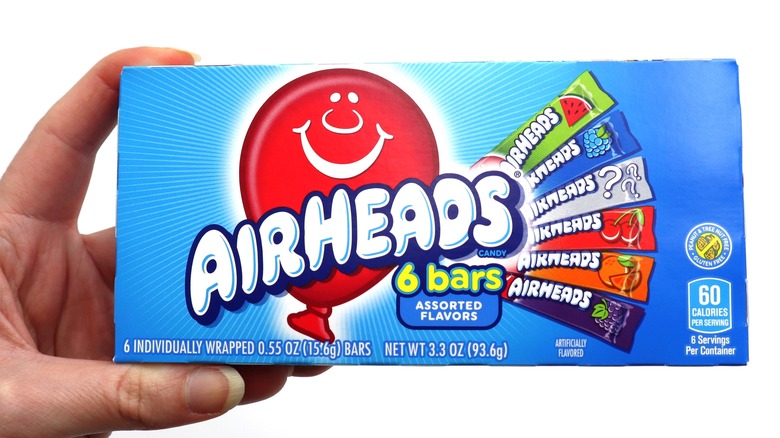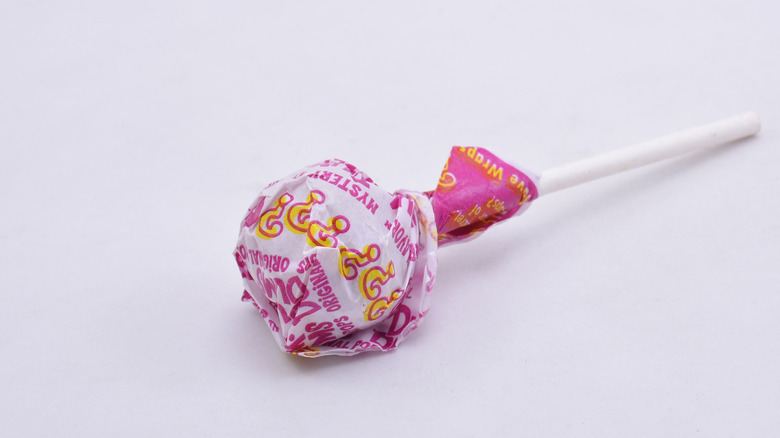Airhead's White Mystery Flavor Isn't A Secret Anymore
Who doesn't love a good mystery? A movie, television show, or book that keeps you on your toes and guessing is always an intriguing, captivating experience, and it's no different with food and drinks. Like playing the game of "Clue," most people are determined to correctly identify the culprit, or flavor, that so mysteriously evades them. In 1993, Airheads (a chewy candy inspired by the polarizing saltwater taffy) became one of the first companies to introduce a Mystery flavor to its lineup of sweets, and fans loved the challenge.
Airheads' White Mystery flavor isn't actually a single, signature flavor. It's a combination of several Airheads flavors that might include cherry, strawberry, watermelon, grape, green apple, orange, and blue raspberry from one day to the next. The creation is actually a brilliant example of marketing and business efficiency. Of course, fans of any product are eager to try something new and fun, and adding a bit of mystery to the mix is a smart way to entice buyers. But the real slick move here is that Airheads doesn't have to stop production in between creating different flavors. Instead of pausing and cleaning the machinery between rounds of, say, cherry and grape, it keeps on churning out candies but withholds the food dye so that the candies turn out white. So the mystery flavors are essentially mashups of whichever flavors are being produced at any given time.
A piece of fan mail inspired the mystery flavor
In the early 1990s, Matthew Fenton was the Assistant Brand Manager of Airheads, and he found himself with a big task: Come up with a new flavor of taffy that would top or at least equal the previous year's big hit, Blue Raspberry. Fenton actually got the idea for a white-colored, mystery-flavored candy from a teenage fan who sent in a suggestion letter. When it came time to test the new white Airheads, the company went directly to its main consumers: kids. Their reactions were precisely what Airheads hoped they would be, with different children guessing different flavors. Almost all of the kids questioned couldn't correctly identify the flavor. It was, indeed, a mystery.
The kicker was that the white "mystery flavor" given to the kids was an existing, popular flavor of Airheads, not a mashup of flavors. But because it was colorless, most of the children couldn't pinpoint the exact flavor, leading the researchers to conclude that physical color (or lack thereof) plays a huge part in how people taste their food. Upon release in 1993, the Mystery flavor shot to the second best-selling flavor of the company's lineup and is still around today.
Mystery flavor makes its mark
Since Airheads launched its mystery-flavored taffy, several other candy and dessert companies followed suit, such as Dum-Dums lollipops in 2001, Starburst, and Twizzlers in 2021 (the mystery flavor was ultimately raspberry). The 2019 Mystery Oreo cookie flavor ended up being churro and, in 2022, Turkey Hill released its own mystery flavor of ice cream, which was eventually revealed to be blueberry pancake. As far as beverages go, Mountain Dew introduced a difficult-to-identify flavor as well.
While many mystery-flavored products forgo the food dye to keep the product's identity extra-concealed, others waive that strategy completely. Ring Pops, for example, release mystery flavors in specific colors to keep customers guessing. Many might assume a green ring pop would taste like apple or watermelon, but that's not necessarily so with these curiously flavored, sweet gems.
Many companies remain mum on how their mystery flavors are made, (likely to keep consumers guessing and intrigued) but it wouldn't come as a surprise if several of them followed Airheads' example. Even if the company has shared the secret behind its mystery, each white Airhead could still taste different from the next, ensuring a surprise flavor on the tongue every time.


